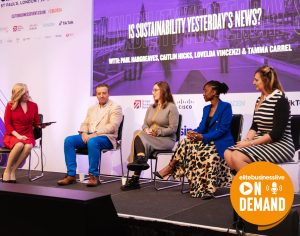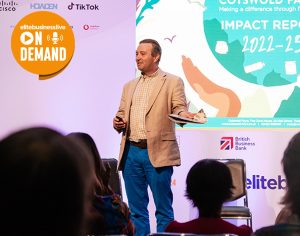It’s a persistent problem symptomatic of what culture strategist turned entrepreneur, Charlie Coode, describes as the “say-do” gap, where leaders recognise the importance of culture, but keep falling short of promises with measures that miss the mark.
From helicopter pilot to culture pioneer
Following a career as a British Army helicopter pilot, experienced analyst turned businessman, Charlie has made it his mission to remedy this ill, pioneering his own innovative culture measurement platform – Culture15 – to drive real-world results.
“There was a formative 11-year period at General Electric between the army and setting up Coode Associates”, says Charlie, explaining how his many roles throughout the years served as inspiration. “This experience convinced me that, not only is culture key to an organisation’s lasting success, but also that it was being done poorly – if at all”, he says.
According to Charlie, vague value statements simply won’t cut it. Indeed, if his time in the army taught him anything, it’s that “in order to lead others – and have them willingly follow you – you must know them as individuals, care for their welfare and put real work into explaining what you are doing” as well.
The ‘say-do’ gap
Yet, many employees still feel culture isn’t a priority – and “in most cases, they’re justified”, says Charlie. “They see evidence that the organisation is not serious about culture all around them… leadership teams saying one thing about cultural expectations, yet acting differently themselves… a prioritisation of results over behaviours and a lack of investment in measuring and managing culture”.
So, what can employers do to take more ownership and overcome this “say-do” gap? Somewhat surprisingly, the answer lies in moving away from employee engagement, according to Charlie.
Employee engagement – just part of the puzzle
“The past ten years have seen massive expansion of the measurement of employee engagement” he states, attributing the success of SaaS-powered survey platforms like Glint, Qualtrix, CultureAmp and Peakon to the leading role that low engagement is reported to hold in the “war for talent”. In fact, a growing number of organisations now use a tech-based model to measure enegagement.
“The challenge is”, he explains, “that whilst measuring engagement is beneficial for organisations, it’s just one part of the culture picture”. As such, he calls for organisations to take the full spectrum of cultural indicators into account, where culture should “be about how people in an organisation behave” as well. In his mind, then, “engagement – or how people are feeling – is an entirely different thing”.
The Culture15 approach
Keen to illustrate how Culture15 resolves this, he explains how the platform takes both behaviours and sentiment into consideration – the difference being that, rather than remaining the primary focus, engagement (sentiment) is seen “as an output of culture”, which he defines more broadly as a series of collective behaviours. In other words, he clarifies, “organisations that are serious about culture see behaviours as the leading indicator of, not just sentiment, but also results, customer experience and so much more” – adding, “after all, people don’t experience your values or sentiment: they only experience your behaviours”.
Setting goals and diagnosing culture
The first step in this new approach, then, is to set some goals. “In order to drive culture forward”, says Charlie, “an organisation must first know what it wants to be and where it wants to go”. This can then be followed up with cultural diagnostics, via the tool, allowing organisations to identify any strengths, roadblocks or significant gaps.
Benchmarking progress
By comparing the two – current and desired – behavioural models, companies can easily benchmark, tracking any cultural progress for demonstrable results over time. This is what he calls “closing the culture gap®” – and it’s a task to be tackled specifically by company leaders – not HR managers, confirms Charlie, who feels companies must avoid the mistake of allowing HR to assume too much ownership of culture. Yes, they should understand cultural issues, but it’s line managers who truly bring culture to life, with HR’s duty being to allow this to happen, “with training, support, metrics, and clear expectations”.
Software success
The question is, then, does this changed approach work? If Culture15’s work with tech manufacturer, Concurrent, is anything to go by, the answer is a resounding ‘yes’. Since Concurrent Technologies began using Culture15’s platform, they have successfully navigated an international acquisition, witnessing a revenue increase of 73% on 2022 figures and seeing share prices soar by 53% in just 12 months. This outstanding growth was partly due to the insights provided by the Culture15 tool, which facilitated effective alignment of their goals, culture and strategy.
A new era of culture management
With data-driven impact so great, excuses such as “you can’t measure culture” and “out culture is already ‘good’” really must be left in the past. “These beliefs may be widely held but prevent organisations from getting serious about culture”, explains Charlie – who believes so firmly in this renewed approach that he’s proud to reveal that Culture15 “takes its own medicine”.
Embracing a shift in cultural thinking
It’s consistent analysis that’s allowed Culture15 to keep growing fast, with a team that’s “changing all the time”, explains Charlie. They “pioneer, do, work, partner and bounce”, remaining unapologetic in the shake-up approach as they embrace team brainstorming and innovation for efficient, focussed solutions that always rise to the challenge.
It’s an energy that’s contagious – despite Charlie’s insistence that it’s not really a revolution. “The really big change is not really technological innovation at all, but a shift in the way businesses typically think about culture”, he humbly claims, ready to help more world-renowned companies take on the future.
Share via:









































